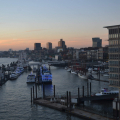ELBPHILHARMONIE
The Elbphilharmonie is not only an architectural feat but also one of the best concert halls in the world.
The flagship of the HafenCity urban project, the Elbphilharmonie is now a landmark of modern Hamburg architecture. Towering 110 metres above the river, its 1,100 windows shimmer like a glass vessel over Hamburg harbour. Known as "The Wave" or "The Lighthouse of Modernity", it attracts a growing number of tourists - both music and architecture fans - to Hamburg. Its architecture, which subtly blends a trapezoidal red-brick former warehouse, typical of the city, with this undulating glass wave, is truly captivating. When the sun falls on this glass structure, giving it a slightly magical shimmering effect, it's even more beautiful. The whole Elbphilharmonie lights up. This superlative building not only houses three concert halls: it also conceals several restaurants, a boutique, a hotel and 44 private apartments.
Plaza. The first time you step inside, you're filled with a sense of exhilaration. Inside, "the tube" - an 80-metre-long, slightly curved, glitter-decorated escalator - sweeps visitors up to the Plaza, one of the city's most beautiful landmarks! The Plaza, 37 meters above ground, offers a circular platform accessible to all free of charge, ideal for admiring Hamburg, the port with its countless cranes and the HafenCity. Thousands of visitors flock here every day. The view is breathtaking, even more so at sunset when the sky turns pink and the windows reflect the last of the sun's rays onto the harbour cranes opposite. The immense port spreads out before our eyes, with its containers, its ships, its smoke..
Hamburg is at our feet, the Philharmonie shines above our heads, and this view is perhaps the best way to appreciate this city of contrasts. A 360° turn around the Plaza reveals the modern port and the Sankt Pauli docks, the warehouse district and all the spires of the old town. A sublime suspended stroll that's hard to tear yourself away from. Looking down, you feel as if you're on the deck of a huge ocean liner, ready to set sail down the Elbe towards the sea and bid farewell to Hamburg. You also have to contemplate the superb corrugated glass doors that give access to the Plaza. You're inside and outside at the same time, thanks to these slightly opaque panes of glass that already give a glimpse of the port and its cranes. You can also enjoy a drink facing the viewpoint, or take a stroll around the boutique. The shop offers countless merchandise items based on the building's distinctive shape: the Elbphilharmonie in a snow globe, in a shortbread mould... but also splendid postcards!
History. Let's take a look back at the history of the building, which opened its doors in January 2017 after a long wait of seven years. The idea for the Philharmonie was proposed in 1999 by architect Alexander Gérard and art historian Jana Marko. The couple felt that it was impossible to build a simple tower at the entrance to the futuristic HafenCity district, and that something was needed for the public. And just as well, since Hamburg is a city of music, it doesn't yet have a Philharmonie. Swiss architects Herzog & de Meuron (London's Tate Modern, Munich's Allianz Arena, Beijing's Olympic Stadium) were commissioned to design the Philharmonie. Their first wave-shaped drawing was the right one. To complete the project, the site had to be raised by 10 metres of bricks, the 80-metre-long curved "tube" had to be built, the building had to be stabilized with pillars, the glass had to be taken to Italy to be curved, and dampers had to be devised to keep out outside noise from the city. A colossal project that ended up costing 11 times more than expected: 866 million euros instead of the 77 million estimated.
Great hall. The pride of Germany's classical music world, the famous concert hall seats 2,100. It is the jewel in the crown of this building, reached by oak staircases. The great hall is a kind of warm, soothing cocoon, dazzling with light and isolated from all extraneous noise. Its exceptional acoustics are due in particular to a wall and ceiling structure called "Weisse Haut" (white skin), made of unique panels of gypsum fibre and recycled paper, which projects sound to the very corners of the room. This marvel is the work of Japanese acoustician Yasuhisa Toyota. It is built on the Weinberg principle: the stage is placed in the center, and the tiers are terraced around it like a ring. This means that no spectator is more than thirty meters from the conductor. It also houses an impressive 4,765-pipe organ! The musical program is varied and eclectic, the Philharmonie being a "House for All". There's classical music, of course, but also jazz, world music, pop and folk, and shows for children. The Elbphilharmonie has also given birth to its own instrumental band.
Did you know? This review was written by our professional authors.
Book the Best Activities with Get Your Guide
Members' reviews on ELBPHILHARMONIE
The ratings and reviews below reflect the subjective opinions of members and not the opinion of The Little Witty.


you can go there as often as you want and it remains a wonder.